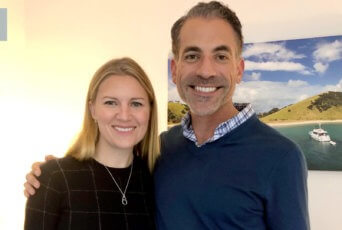While our society tends to treat teeth as somehow separate from the rest of our body, the truth is that our oral health gives us vital clues into our overall health. Integrative dentist Dr. Reid Winick, D.D.S., founded Dentistry for Health New York with the goal of spreading this truth and helping people get to the root cause of their ailments. For the past 20 years, he has practiced integrative dentistry, helping his patients with a variety of health issues, both oral and non-oral. Read on to learn how he discovered integrative dentistry, why eating alkalizing foods is so important for your oral health, how to truly stop chronic bad breath, and more.
*This is a short clip of our interview with Dr. Winick. Click here to watch the whole thing!*
You can also listen to an audio version of our interview with Dr. Reid Winick on The WellBe Podcast.
Integrative Dentistry Explained
Integrative medicine is the practice of treating a person as a whole human, rather than addressing individual symptoms. So integrative dentistry, it follows, is an approach to dentistry that considers the whole person and all of their interconnected systems, to diagnose and treat issues in the mouth, gums, and teeth. While most dentists just focus on what’s going on in your mouth, Dr. Winick says that they should take a much more holistic and broad approach.
“The bottom line is, your mouth is a barometer for your overall wellness,” he says. “If you start seeing a breakdown in your mouth, then you almost know that ten years later, twenty years later, you’re going to see a breakdown in the rest of your body.” A medical breakdown, he points out, is far more expensive to treat than a dental one, and much more likely to cause a major disruption and permanent changes to your life and lifestyle.
Integrative dentistry focuses on avoiding any sort of breakdown by “teaching the body to be sustainable,” as Dr. Winick describes it. That means that if you get frequent cavities or other dental problems, you should think holistically. So rather than just avoiding fluoride or mercury or flossing more, think about how your body and bodily systems are doing as a whole. “It’s not just about cleaning your teeth and sterilizing the area, it’s about working on the entire body, because if the body is healthy, the mouth will heal on its own,” he says.
Another important element of integrative dentistry is empowering patients to make their own decisions about their dental health. “I think a big part of being a holistic dentist is giving the patient the right to know what’s going on in their mouth, letting them choose what direction they want to go in, and then supporting them,” he says. “If you go to a caregiver, whether it’s a doctor or your dentist, you have a right to ask them questions. And if they don’t have an answer to your questions, then you know you’re in the wrong place.”
Using Integrative Dentistry to Heal Crohn’s Disease
Dr. Winick wasn’t always an integrative dentist. In fact, he had been practicing conventional dentistry for some time when he made the switch.
He was at a TMJ facial pain seminar, where he heard several doctors discussing chronic pain, and they mentioned Crohn’s disease. This struck a chord with him, because he’d dealt with Crohn’s disease since childhood, enduring multiple surgeries, getting sick frequently, and even going on disability at one point. The doctors at the seminar explained that Crohn’s was often an allergy to gluten, and Dr. Winick was shocked. He’d been to the best doctors in New York City, and nobody ever suggested that he might be allergic to gluten.
Dr. Winick was curious about this hypothesis, so he cut gluten out of his diet. Within five days, all of his symptoms had disappeared. He flew out to Seattle, where the doctors from the seminar were based, and was treated by them. Once he was fully healed, he took their seminars, and it completely changed the trajectory of his career.
“They taught me how the mouth and the body are connected,” he says. From that point on, Dr. Winick left behind aesthetic dentistry and began practicing holistic, integrative dentistry. “I converted my whole practice,” he says.
Why Alkalizing Foods Matters for Your Dental (and Overall) Health
One of the primary things you can do to keep your mouth and body healthy is eating an alkaline diet, according to Dr. Winick. To explain why, here’s a (kind of gruesome) analogy: do you ever think about how a corpse in a coffin can deteriorate even without bugs getting into the coffin to eat it? It’s because the bugs are already in the body’s gut. See, as soon as you die, your body becomes acidic, and that really starts to break things down, says Dr. Winick. Sensing the body’s rising acidity, the bugs get to work. We know, ew.
But the thing is, your body can become acidic when you’re alive, too. High acidity in your body is a sign to your cells that things aren’t going too well, and can lead to other issues. As Dr. Winick put it, “if you’re walking around, and your body is too acidic, the bugs think you’re dying and they start creating disease in your body.”
Luckily, there are things you can do stay alkaline, including:
- Eating a good, balanced diet that includes alkalizing foods like fruits and vegetables, nuts, seeds, and legumes
- Getting adequate exercise
- Drinking lots of healthy water
- Maintaining a positive mindset
“Learn what your body needs and doesn’t need in terms of proper nutrition,” advises Dr. Winick. “You should have a diet that’s more alkalizing. If your body is alkaline, then you won’t be prone to cavities, and then you won’t need fluoride”
Why Diagnosing the Cause of Chronic Bad Breath Beats Mouthwash
“Bad breath is a big concern for a lot of patients,” says Dr. Winick. While many people are tempted to just treat their chronic bad breath with mouthwash or more frequent brushing, Dr. Winick says the most important thing is to diagnose the underlying cause of the issue.
Bad breath can come from a number of causes, either related to the gut (meaning that the food you’re eating isn’t being digested properly, for whatever reason), or the mouth (gum disease, pocketing, or other oral infections). In order to treat chronic bad breath, you have to first know which cause is the culprit. “You can’t just guess,” says Dr. Winick. “You need to do a test.” He recommends seeing a qualified hygienist who understands all the factors at play.
If you’ve been tested and ascertained that the issue is in your mouth, then it’s important to know that you can’t just floss away the issue. The bugs causing the chronic bad breath are very smart, and if you use floss, a Waterpik, or a hygiene scaler in your mouth, all the bugs scatter so that they can’t be killed. In a few weeks, they return and begin wreaking havoc again.
To truly kill them and stop bad breath, you need to completely sterilize or fumigate the pockets where the bugs are hiding. “I’m not talking about high-alcohol rinses,” he says. “We have essential oils, we have ozone, we use a CO2 laser.” This will kill the bugs causing the bad breath, and thus prevent them from coming back.
(Note that just because floss, Waterpiks, and hygiene scalers can’t treat chronic bad breath doesn’t meant you shouldn’t use them! They help keep your mouth healthy in many other ways. For a full list of WellBe-approved dental hygiene products (plus 1,200+ more researched and vetted items, from food to sleep aids to beauty products and more), check out the WellBe Non-Toxic Product Lists.)
Watch the full WellBe interview with Dr. Winick to learn why flossing isn’t as great as we all think it is, how hidden infections in the mouth can lead to larger issues with your body, the many different types of tests that can reveal what’s going on with your oral health, how an integrative dentist works with a patient’s doctors, the truth about fluoride and your health, and much more.
You can also listen to an audio version of our interview with Dr. Reid Winick on The WellBe Podcast.
The information contained in this article comes from our interview with Dr. Reid Winick, D.D.S. His qualifications and training include graduating from the New York University College of Dentistry. Dr. Winick is a past co-founder and director of the Facial Pain/TMJ Clinic at NY Eye & Ear Infirmary. He has completed numerous continuing education courses with an emphasis on TMJ & cervical dysfunction, neural therapy, and biological dentistry. Dr. Winick also lectures, writes, and teaches on green dentistry, TMJ, head, neck & facial pain. You can learn more about him here.
Citations:
- Deep, S. Integrative Dentistry: A Practical Approach. IOSR Journal of Dental and Medical Sciences (IOSR-JDMS) e-ISSN: 2279-0853, p-ISSN: 2279-0861.Volume 15, Issue 9 Ver. IX (September). 2016), PP 85-87.
- Festen, E. et al. A meta-analysis of genome-wide association scans identifies IL18RAP, PTPN2, TAGAP, and PUS10 as shared risk loci for Crohn’s disease and celiac disease. PLoS Genet. 2011 Jan 27;7(1):e1001283.
- Donaldson, A. et al. “Biochemistry changes that occur after death: potential markers for determining post-mortem interval.” PloS one vol. 8,11 e82011. 21 Nov. 2013,








COMMENTS